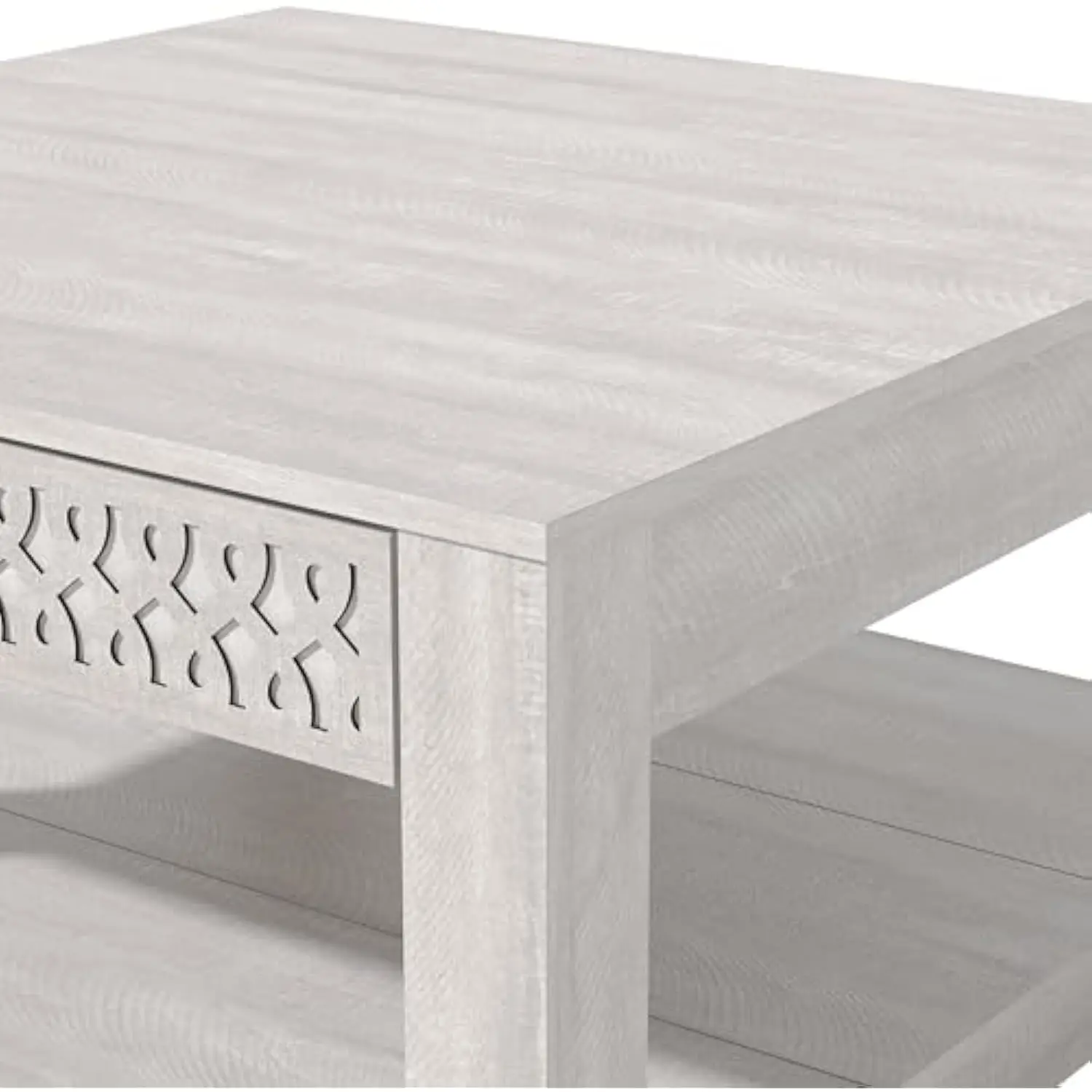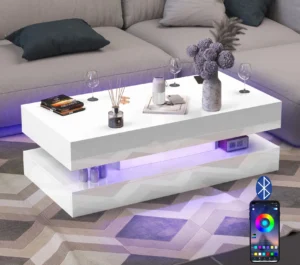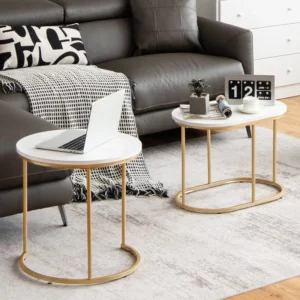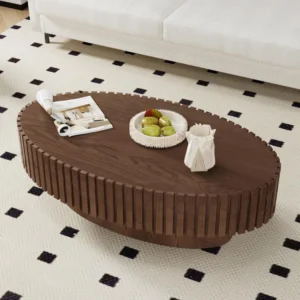Introduction: Why Square Coffee Table Dimensions Matter
A square coffee table stands as a distinctive centerpiece in home furnishing, characterized by its equal-length sides that create perfect symmetry in your living space. Unlike rectangular tables, square coffee tables offer unique balance and visual harmony that can transform an ordinary room into a well-designed haven. But achieving this transformation isn’t simply about selecting any square table—it requires understanding the ideal dimensions that work with your specific space and furniture.
The importance of proper sizing extends beyond mere aesthetics. A table that’s too large can obstruct movement and make your space feel cramped, while one that’s too small might look insignificant and fail to serve its functional purpose. Height, width, and proportionality all play crucial roles in creating a coffee table that feels “just right” in your living area.
Many design principles that guide square coffee table proportions draw from intelligent black mid-century coffee tables traditions, where form follows function in the most elegant way possible. The clean lines and intentional proportions of these designs continue to influence modern furniture today, especially in mid-century modern square coffee tables that maintain perfect balance between visual appeal and practicality.
Imagine walking into a living room where an oversized square table forces you to squeeze sideways past furniture, versus one where a perfectly proportioned table invites conversation and comfort—the difference lies in understanding ideal dimensions before making your selection.
Benefits of Square Coffee Tables: When They Work Best
Square coffee tables offer distinct advantages that make them perfect for certain spaces and seating arrangements. Their inherent symmetry creates a sense of balance that rectangular or irregular tables simply cannot match. This balanced visual weight becomes particularly noticeable in open-concept living spaces where the coffee table serves as an anchoring element.
One of the most compelling reasons to choose a square coffee table is its perfect compatibility with L-shaped and U-shaped sectionals. The square shape mirrors the right angles of these seating arrangements, creating a harmonious conversation area where everyone has equal access to the table surface. This democratizes the space, ensuring no one feels left out during gatherings.
Square tables excel at facilitating conversation for several key reasons:
– They provide equal access from all four sides
– No one sits at the “head” of a square table, creating visual equality
– They create natural conversation zones by establishing boundaries
– They allow for symmetrical arrangement of decorative elements
The space efficiency benefits become evident in specific layouts, particularly in rooms with square dimensions or central seating arrangements. Rather than creating awkward gaps or unusable spaces that can happen with rectangular tables, square coffee tables maximize functional surface area while maintaining proper clearance around all sides.
Decorating black mid-century coffee tables with square proportions allows you to create striking visual statements that honor the design principle that form should follow function. The clean, balanced lines of square tables particularly complement the geometric precision found in mid-century design aesthetics.
When choosing between different table shapes, many homeowners struggle with the decision between round or square coffee table for sectional seating. While round tables create flow with their absence of corners, square tables maximize usable surface area and create visual cohesion with the angles of sectional furniture.
The Golden Rules: Essential Coffee Table Sizing Principles
The Height Rule: Perfect Alignment with Seating
The height of your square coffee table plays a crucial role in both comfort and visual harmony. The standard guideline that most designers follow is positioning your table 1-2 inches below the height of your sofa seat cushions. This relationship creates an ergonomic arrangement that allows for comfortable access while maintaining proper proportions.
For most living rooms, this translates to a coffee table height between 16-18 inches (40-46 cm) from the floor. However, some design approaches suggest that matching the table height exactly to the seat height can create a more cohesive, intentional look—particularly in contemporary spaces.
Your sofa type should influence your height decision:
– For sofas with firm cushions: Choose a table equal to or no more than 1 inch below seat height
– For plush/soft cushions: Select a table 2-3 inches below seat height to accommodate cushion compression
– For low-profile modern sofas: Lower coffee tables (14-16 inches) maintain appropriate proportions
– For traditional higher sofas: Taller coffee tables (17-19 inches) preserve comfortable reach distances
Finding this perfect height balance ensures that using your coffee table feels natural, whether you’re setting down a drink, propping up your feet, or playing a board game with friends.
The Proportionality Rule: Balanced Dimensions
The relationship between your coffee table size and surrounding furniture creates the foundation for visual harmony in your living space. For square coffee tables, the classic two-thirds rule provides an excellent starting point: your coffee table should be approximately two-thirds the length of your sofa.
For example:
– If your sofa is 84 inches long, an ideal square coffee table would be about 56 inches on each side
– For a 72-inch sofa, a 48-inch square table maintains proper proportion
– With a smaller 60-inch loveseat, a 40-inch square table preserves balance
However, square tables present unique proportional considerations since their width equals their length. This can create substantial visual weight, especially in larger sizes. In smaller spaces, you might adjust this rule slightly downward to prevent the table from overwhelming the room.
The primary goal is creating visual balance while ensuring functional space. A table that’s properly proportioned to your sofa creates a cohesive seating area that feels intentionally designed rather than randomly assembled. Black mid-century modern coffee table styles exemplify how these proportional relationships contribute to the timeless appeal of well-designed furniture.
The Clearance Rule: Space for Comfort and Movement
Proper clearance around your square coffee table ensures comfortable use and smooth movement throughout your living space. The ideal distance between your sofa and coffee table should be 12-18 inches (30-46 cm)—close enough for easy reach while leaving sufficient legroom.
Beyond the sofa-facing side, maintaining appropriate walkway clearance becomes essential for room flow and accessibility. Design standards recommend a minimum of 24-30 inches (61-76 cm) of clear space around the remaining sides of the table to allow comfortable passage.
For spaces requiring accessibility considerations, these clearances should increase to accommodate mobility aids:
– Pathways should provide at least 36 inches (91 cm) of clear width
– Turn spaces around furniture should allow for 60-inch (152 cm) diameter clearance
– Approach areas should provide sufficient space for comfortable navigation
Proper clearance not only improves functionality but also creates visual breathing room that prevents your space from feeling cramped or cluttered. When measuring for your ideal square coffee table, always consider these clearance requirements as non-negotiable minimums rather than targets.
Square Coffee Table Sizing Guide: Finding Your Perfect Match
Ideal Dimensions Based on Room and Furniture Size
Selecting the perfect square coffee table dimensions requires balancing room size, seating scale, and functional needs. The following guidelines help match table dimensions to your specific living space:
| Room Size | Sofa Length | Ideal Square Table Size | Height Range |
|---|---|---|---|
| Small (Under 200 sq ft) | 60-72 inches | 30×30 to 36×36 inches | 16-17 inches |
| Medium (200-300 sq ft) | 72-84 inches | 36×36 to 42×42 inches | 16-18 inches |
| Large (Over 300 sq ft) | 84+ inches | 42×42 to 48×48 inches | 16-19 inches |
For small spaces, consider tables in the 30×30 to 36×36 inch range (76×76 to 91×91 cm). These dimensions provide sufficient surface area without overwhelming more intimate settings. A 36-inch square table works particularly well with apartment-sized sofas and loveseats between 60-72 inches in length.
Medium spaces can comfortably accommodate square tables between 38×38 to 42×42 inches (97×97 to 107×107 cm). These dimensions create substantial presence while maintaining proper clearance in average-sized living rooms. Tables in this range pair well with standard three-seat sofas measuring 72-84 inches long.
Large living areas benefit from more substantial tables measuring 44×44 inches (112×112 cm) or larger. These generous dimensions create appropriate scale in spacious rooms and provide ample surface area for both decorative and functional purposes. When paired with sectionals or longer sofas, these larger square tables create balanced proportions.
Mid-century modern large coffee tables typically feature these more generous dimensions while maintaining the clean lines and perfect proportions characteristic of the style.
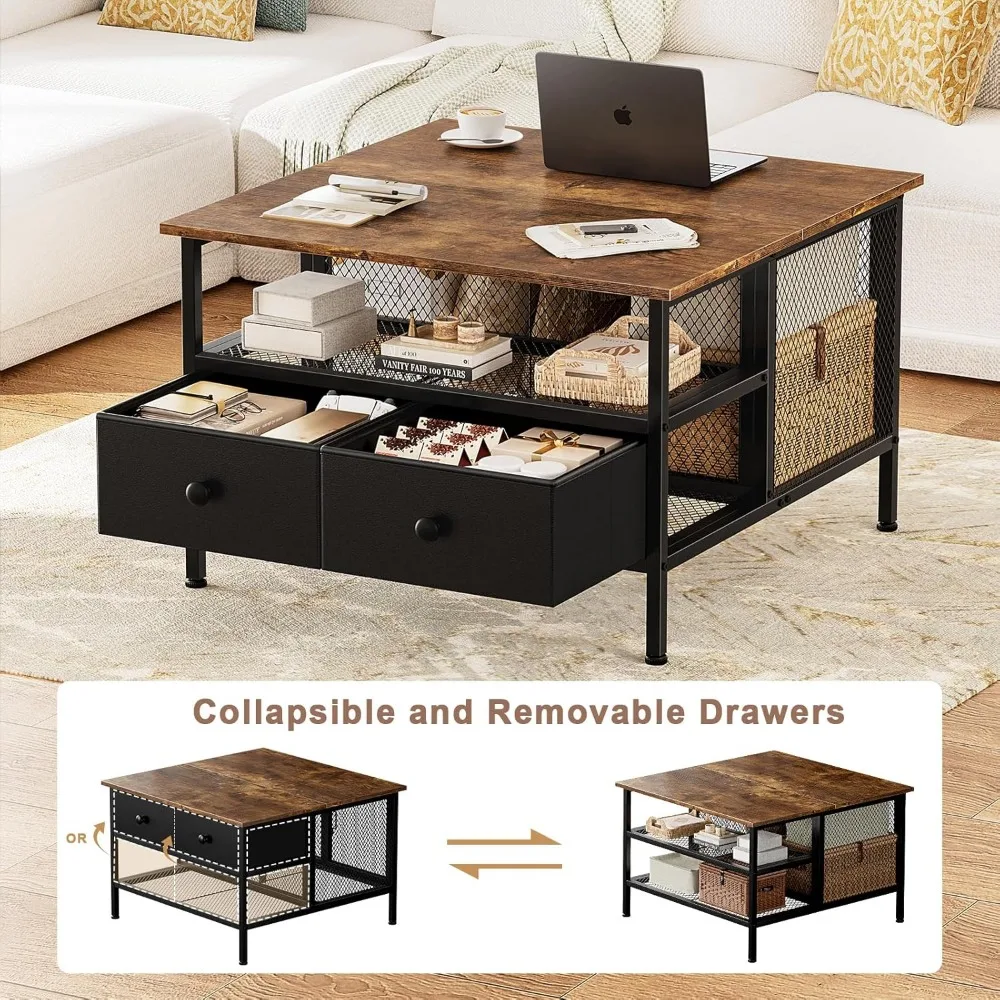
Height Considerations for Square Tables
While we’ve discussed the standard height range of 16-18 inches (40-46 cm) for coffee tables, square tables present specific height considerations worth exploring. The visual weight of a square table—particularly larger ones—means height plays a crucial role in how substantial the piece appears in your space.
Key height considerations for square coffee tables include:
- Lower-profile tables (14-16 inches) create a more modern, casual appearance and work well with contemporary low-slung sofas
- Standard height tables (16-18 inches) offer versatile compatibility with most seating styles
- Taller tables (18-19 inches) provide easier access for those with mobility concerns and pair well with higher traditional seating
- The table’s construction—particularly leg style and base thickness—affects how the height is perceived visually
For special seating arrangements, height adjustments may be necessary. Very low lounge seating might require coffee tables as low as 12-14 inches, while higher dining-style seating could accommodate tables up to 20-22 inches high. Always prioritize the relationship between your specific seating height and table height over generic guidelines.
Mid-Century Modern Solid Wood Coffee Tables, Mid-Century Modern Teak Coffee Tables
$879.95 Select options This product has multiple variants. The options may be chosen on the product pageMid-Century Modern Danish Coffee Tables, Mid-Century Modern Oval Coffee Tables, Mid-Century Modern Solid Wood Coffee Tables
$390.05 Select options This product has multiple variants. The options may be chosen on the product pageMid-Century Modern Lift Top Coffee Tables, Mid-Century Modern Square Coffee Tables
$454.73 Select options This product has multiple variants. The options may be chosen on the product pageMid-Century Modern Large Coffee Tables, Mid-Century Modern Rectangular Coffee Tables
$603.26 Select options This product has multiple variants. The options may be chosen on the product pageMid-Century Modern Nesting Coffee Tables, Mid-Century Modern Nesting Table Sets
$361.45 Select options This product has multiple variants. The options may be chosen on the product pageMid-Century Modern Oval Coffee Tables, Mid-Century Modern Solid Wood Coffee Tables
$679.56 Select options This product has multiple variants. The options may be chosen on the product page
Pairing Square Coffee Tables with Different Seating Arrangements
Sectional Sofa Pairings: Maximizing Space and Function
Square coffee tables find their perfect match in sectional sofas, particularly those with L-shaped configurations. The geometric harmony between right-angled sectionals and square tables creates a cohesive, intentional look that enhances both functionality and visual appeal.
For L-shaped sectionals, position your square coffee table centered in the open area created by the two sections. This placement maximizes accessibility from both sides of the sectional while creating balanced negative space. The ideal square table should measure approximately two-thirds the length of the sectional’s longest side to maintain proper scale.
U-shaped sectionals require special consideration when pairing with square tables:
– The table should be proportional to the central opening (typically 36-48 inches square)
– Ensure at least 18 inches of clearance between the table and each section of the seating
– Consider how traffic flows through and around the U-shape when determining exact placement
– For very large U-sectionals, two smaller square tables might work better than one oversized table
Sectionals with chaise lounges present a hybrid configuration that benefits from the structured boundaries a square table provides. Position the table to align with the main sofa section while leaving the chaise portion open for comfortable lounging.
When deciding between different table shapes for your sectional, comparing the benefits of square vs round coffee table layout can help determine which option best suits your specific arrangement and room flow.
Standard Sofa and Multi-Piece Seating Arrangements
While sectionals naturally complement square coffee tables, standard sofas and mixed seating groups can also benefit from the balanced proportions these tables provide. For a standard three-seat sofa measuring 72-84 inches, a square coffee table between 36-42 inches creates ideal proportions following the two-thirds rule.
When working with multiple smaller seating pieces like a pair of loveseats or a collection of armchairs, a square coffee table creates a natural focal point that unifies the arrangement. Position the table centrally with equal distance to each seating element to create a balanced conversation area.
For conversation groups featuring four chairs arranged in a square, center a square coffee table with at least 18 inches of clearance from each chair. This arrangement creates perfect symmetry while ensuring everyone can comfortably reach the table.
When mixing seating heights—such as combining a standard sofa with lower-profile chairs—choose a coffee table height that splits the difference or favors the primary seating piece. This compromise ensures reasonable ergonomics for all seating positions while maintaining visual cohesion.
Beyond Measurements: Design Factors Affecting Perceived Size
The physical dimensions of your square coffee table tell only part of the story—design elements significantly impact how large or substantial the table appears in your space. Material choices create dramatic differences in visual weight even when dimensions remain identical. Glass-topped square tables appear lighter and less imposing than solid wood versions of the same size, making them suitable for smaller spaces where substantial dimensions are still desired.
Table base and leg design dramatically affects perceived size and heaviness. Consider how these design elements alter visual weight:
– Solid block bases create maximum visual weight and presence
– Thin legs with open undersides minimize visual weight
– X-shaped or diagonal supports create dynamic visual interest without heaviness
– Cantilevered designs create a floating appearance that reduces perceived bulk
Surface treatments and finishes further modify how dimensions are perceived. High-gloss surfaces reflect light and visually expand the table’s presence, while matte or textured finishes absorb light and appear more grounded. Dark finishes typically make tables appear more substantial, while lighter tones create an airier impression.
Mid-century modern design principles embrace clean lines and organic materials that inherently affect table presence. The honest expression of materials and thoughtful proportions characteristic of mid-century modern nesting coffee tables demonstrate how design elements can create tables that feel perfectly scaled regardless of their actual dimensions.
Practical Measurement Guide: Finding Your Ideal Dimensions
Finding the perfect square coffee table dimensions requires more than theoretical knowledge—it demands practical measurement techniques that translate these principles to your specific space. Follow these steps to determine your ideal dimensions:
- Measure your sofa length from arm to arm using a tape measure
- Calculate two-thirds of that length to determine your target square table size
- Check sofa seat height by measuring from the floor to the top of the cushion
- Subtract 1-2 inches from seat height to determine ideal table height
- Map potential table placement using painter’s tape on the floor, creating a square outline
- Measure clearances from this outline to all surrounding furniture and walkways
- Adjust outline dimensions if needed to maintain minimum clearances
- Create a cardboard template at your finalized dimensions to visualize the size in 3D space
For accurate measurements, use these tools:
– Retractable tape measure for furniture dimensions
– Laser measure for room dimensions and longer distances
– Carpenter’s square to ensure accurate right angles when mapping square shapes
– Level to ensure height measurements account for uneven floors
This methodical approach helps visualize how your square coffee table will fit before making a purchase, preventing costly sizing mistakes and ensuring optimal function and appearance.
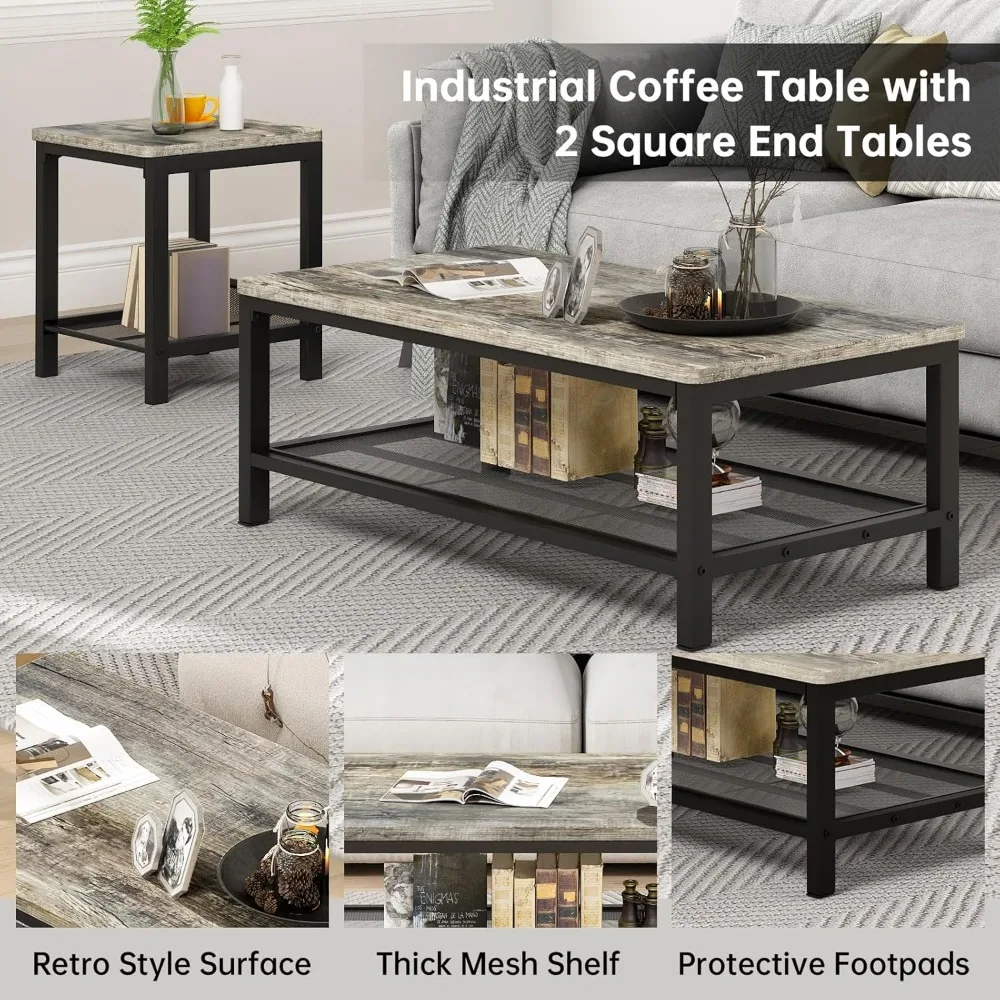
Dimensional Pitfalls: Common Square Coffee Table Mistakes
Even with careful planning, several common dimensional mistakes can compromise the function and appearance of your square coffee table. Being aware of these pitfalls helps ensure successful selection and placement.
Oversized Table Syndrome: Perhaps the most common error is choosing a square table that’s too large for the space. This creates obstacles to movement, forces awkward navigation around furniture, and makes the room feel cramped. The mistake often occurs when focusing only on the relationship to the sofa while ignoring overall room scale. Always verify that your chosen dimensions allow for proper clearances on all sides.
The Miniature Table Problem: Conversely, undersized tables create functional and visual issues. A square coffee table that’s too small forces people to lean uncomfortably far forward to reach items and creates a visually unbalanced relationship with surrounding furniture. This commonly happens when prioritizing open space over functional proportions. Remember that the two-thirds rule provides a minimum target size rather than a maximum.
Height Misalignment: Tables that are significantly higher or lower than your seating create ergonomic discomfort and visual discord. This mistake typically results from purchasing without measuring existing furniture or failing to account for cushion compression. Always test the height relationship before finalizing your purchase, particularly with mid-century modern solid wood coffee tables where height adjustments aren’t typically possible.
Clearance Congestion: Insufficient space around your coffee table restricts movement and creates a cramped feeling that diminishes enjoyment of your living space. This error commonly occurs when trying to fit oversized furniture into limited spaces. Always maintain minimum clearances of 12-18 inches to the sofa and 24-30 inches for walkways to ensure comfortable navigation.
Scale Inconsistency: Ignoring the overall scale relationship between your coffee table and room dimensions creates proportion problems that feel visually jarring. A massive square table in a modest room feels overwhelming, while an appropriately-sized table maintains harmony. Consider both furniture relationships and room dimensions when determining ideal table proportions.
Quick Reference: Square Coffee Table Dimension Checklist
Use this quick reference guide to ensure your square coffee table dimensions create the perfect balance of form and function in your living space:
Height Measurements:
– Standard coffee table height: 16-18 inches (40-46 cm)
– Relationship to sofa: 1-2 inches below seat cushion height
– For firm sofas: Equal to or 1 inch below seat height
– For soft/plush sofas: 2-3 inches below expanded seat height
Square Table Dimensions:
– Small spaces: 30×30 to 36×36 inches (76×76 to 91×91 cm)
– Medium spaces: 38×38 to 42×42 inches (97×97 to 107×107 cm)
– Large spaces: 44×44 to 48×48 inches (112×112 to 122×122 cm)
– Oversized spaces: 50×50 inches (127×127 cm) or larger
Clearance Requirements:
– Between sofa and table: 12-18 inches (30-46 cm)
– Walkway clearance around other sides: 24-30 inches (61-76 cm)
– For accessible spaces: Minimum 36 inches (91 cm) pathways
– Overall proportion guideline: Table width approximately two-thirds sofa length
Mid-Century Modern Design Checkpoints:
– Clean, uncluttered lines with intentional proportions
– Balanced visual weight between table and surrounding furniture
– Natural materials that showcase authentic textures
– Functional design that serves practical needs while maintaining visual appeal
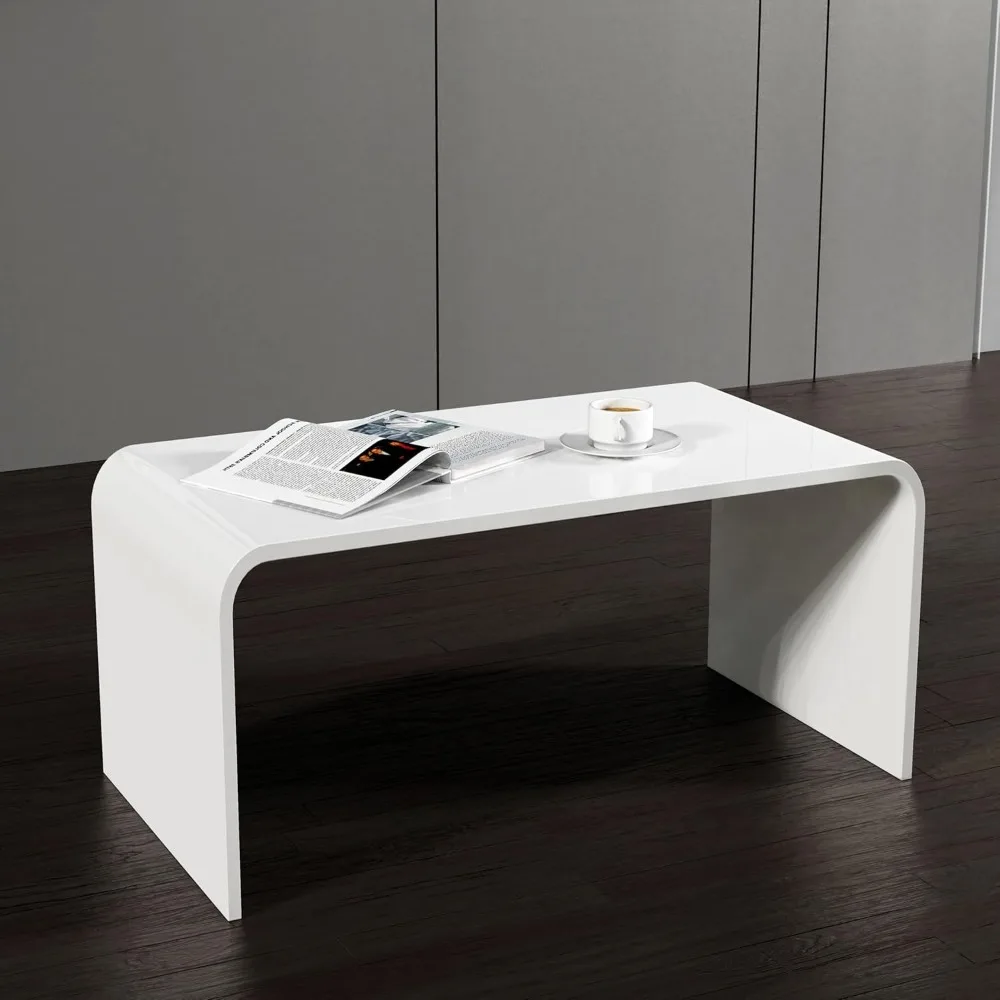
Bringing Balance Home: Square Tables That Transform Your Space
The perfect square coffee table does more than simply provide a surface for drinks and magazines—it creates visual anchor that brings your entire living space into harmony. By following the dimensional principles outlined in this guide, you’ll be able to select a table with proportions that feel intentional and balanced rather than arbitrary.
Remember that ideal dimensions work together as a system: height, width, and clearance all contribute to both the visual impact and functional success of your coffee table. While the guidelines provided offer reliable starting points, don’t be afraid to adjust them slightly based on your specific furniture, room layout, and personal preferences.
The timeless appeal of mid-century modern square coffee tables stems from their thoughtful proportions and balance between form and function. These principles remain relevant regardless of changing design trends because they’re rooted in human ergonomics and visual harmony rather than passing fashions.
By applying these dimensional principles thoughtfully, you’ll create a living space that feels cohesive, comfortable, and intentionally designed. The perfect square coffee table becomes not just a piece of furniture, but a transformative element that elevates your entire room.

